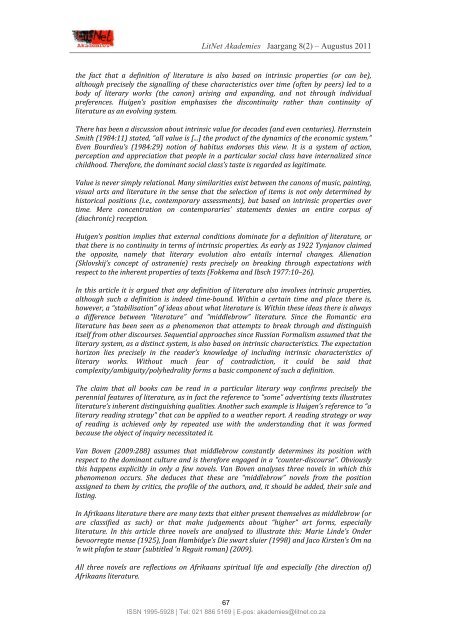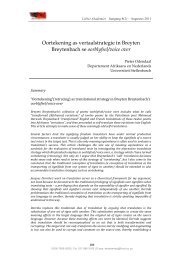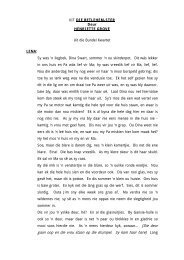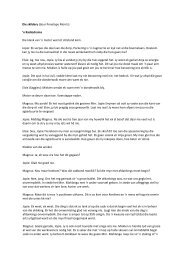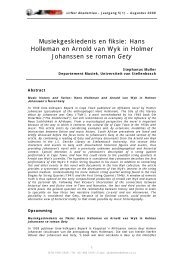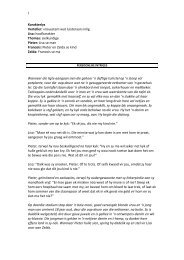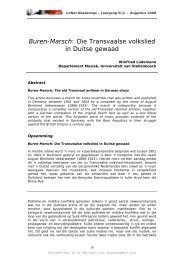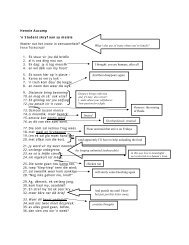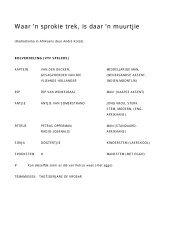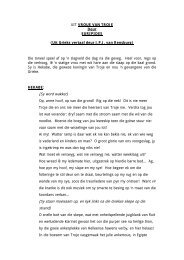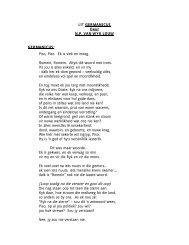Jaargang 8, nommer 2 – Augustus 2011 - LitNet
Jaargang 8, nommer 2 – Augustus 2011 - LitNet
Jaargang 8, nommer 2 – Augustus 2011 - LitNet
Create successful ePaper yourself
Turn your PDF publications into a flip-book with our unique Google optimized e-Paper software.
<strong>LitNet</strong> Akademies <strong>Jaargang</strong> 8(2) <strong>–</strong> <strong>Augustus</strong> <strong>2011</strong><br />
the fact that a definition of literature is also based on intrinsic properties (or can be),<br />
although precisely the signalling of these characteristics over time (often by peers) led to a<br />
body of literary works (the canon) arising and expanding, and not through individual<br />
preferences. Huigen’s position emphasises the discontinuity rather than continuity of<br />
literature as an evolving system.<br />
There has been a discussion about intrinsic value for decades (and even centuries). Herrnstein<br />
Smith (1984:11) stated, “all value is [...] the product of the dynamics of the economic system.”<br />
Even Bourdieu’s (1984:29) notion of habitus endorses this view. It is a system of action,<br />
perception and appreciation that people in a particular social class have internalized since<br />
childhood. Therefore, the dominant social class’s taste is regarded as legitimate.<br />
Value is never simply relational. Many similarities exist between the canons of music, painting,<br />
visual arts and literature in the sense that the selection of items is not only determined by<br />
historical positions (i.e., contemporary assessments), but based on intrinsic properties over<br />
time. Mere concentration on contemporaries’ statements denies an entire corpus of<br />
(diachronic) reception.<br />
Huigen’s position implies that external conditions dominate for a definition of literature, or<br />
that there is no continuity in terms of intrinsic properties. As early as 1922 Tynjanov claimed<br />
the opposite, namely that literary evolution also entails internal changes. Alienation<br />
(Sklovskij’s concept of ostranenie) rests precisely on breaking through expectations with<br />
respect to the inherent properties of texts (Fokkema and Ibsch 1977:10<strong>–</strong>26).<br />
In this article it is argued that any definition of literature also involves intrinsic properties,<br />
although such a definition is indeed timebound. Within a certain time and place there is,<br />
however, a “stabilisation” of ideas about what literature is. Within these ideas there is always<br />
a difference between “literature” and “middlebrow” literature. Since the Romantic era<br />
literature has been seen as a phenomenon that attempts to break through and distinguish<br />
itself from other discourses. Sequential approaches since Russian Formalism assumed that the<br />
literary system, as a distinct system, is also based on intrinsic characteristics. The expectation<br />
horizon lies precisely in the reader’s knowledge of including intrinsic characteristics of<br />
literary works. Without much fear of contradiction, it could be said that<br />
complexity/ambiguity/polyhedrality forms a basic component of such a definition.<br />
The claim that all books can be read in a particular literary way confirms precisely the<br />
perennial features of literature, as in fact the reference to “some” advertising texts illustrates<br />
literature’s inherent distinguishing qualities. Another such example is Huigen’s reference to “a<br />
literary reading strategy” that can be applied to a weather report. A reading strategy or way<br />
of reading is achieved only by repeated use with the understanding that it was formed<br />
because the object of inquiry necessitated it.<br />
Van Boven (2009:288) assumes that middlebrow constantly determines its position with<br />
respect to the dominant culture and is therefore engaged in a “counterdiscourse”. Obviously<br />
this happens explicitly in only a few novels. Van Boven analyses three novels in which this<br />
phenomenon occurs. She deduces that these are “middlebrow” novels from the position<br />
assigned to them by critics, the profile of the authors, and, it should be added, their sale and<br />
listing.<br />
In Afrikaans literature there are many texts that either present themselves as middlebrow (or<br />
are classified as such) or that make judgements about “higher” art forms, especially<br />
literature. In this article three novels are analysed to illustrate this: Marie Linde’s Onder<br />
bevoorregte mense (1925), Joan Hambidge’s Die swart sluier (1998) and Jaco Kirsten’s Om na<br />
’n wit plafon te staar (subtitled ’n Reguit roman) (2009).<br />
All three novels are reflections on Afrikaans spiritual life and especially (the direction of)<br />
Afrikaans literature.<br />
67<br />
ISSN 1995-5928 | Tel: 021 886 5169 | E-pos: akademies@litnet.co.za


